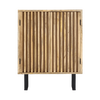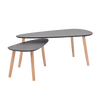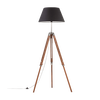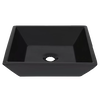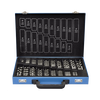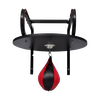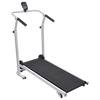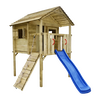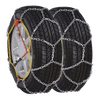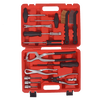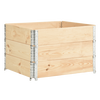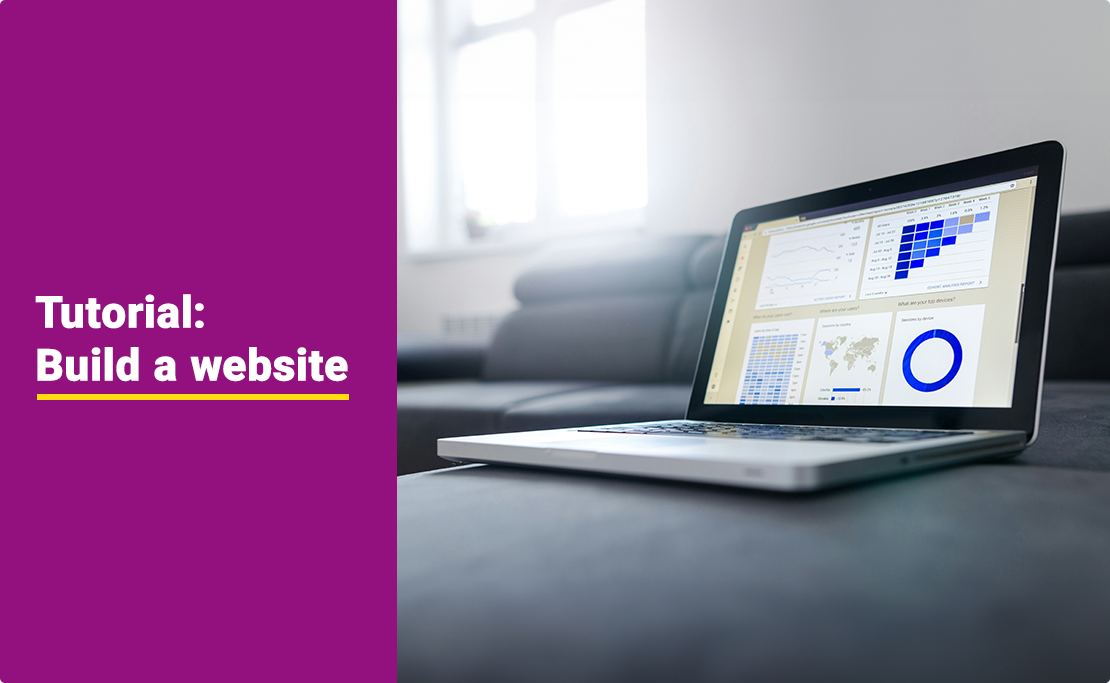1. Buy a domain name
Before you start building a website, you will need to buy a domain name. This is the URL for your website. Thankfully, most options are very affordable and it only takes a few minutes to purchase. Domain names are paid annually.
Finding a domain name company
You can do an online search to find a domain registrar company. Popular domain registrars include GoDaddy, Google Domains, and Namecheap. It's also possible to register your domain name through a website builder, if this is how
you will build your website. Or you can use a web-hosting provider such as Hostinger, HostGator, or Bluehost.
Registering a domain name
Your domain name should be
the name of your business . However, if it is already taken or it's very long, then think about amending it to find a
domain name that fits.
Tips:
-
Choose a short domain name to make sure it's easy to remember and spell correctly.
- Opt for keywords that relate to your business if your brand name is already taken.
- You can purchase and use multiple domain names for one website (this is great for blocking others from using your brand name and increasing the likelihood of customers finding your website).
Choosing a domain name extension
The end of the URL is a domain name extension. For example, .com and .org. The main difference is the price point. Some options are much cheaper than others.
- .com is the most well-known and trusted domain name extension. It is short for commerce but is widely used for all types of websites.
.co.uk, .com.au, .es, .it are examples of domain extensions based on country. This is useful for ecommerce websites that specialise in one geographical market.
- .org is another highly trusted domain extension. It is short for organisation. It's usually used by non-profit companies.
- .co is a new domain extension. It is an acronym for company, which is recognised in multiple languages.
- .net is another well-known extension that refers to any type of website.
- .cycling, .pets, .toys, .kids, .decor, and .store are some examples of new and interesting domain extensions. These range in price but are a nice alternative to stand out from the crowd while using keywords.
Point the domain name to your website
Once you have your domain name, you will need to connect it to your hosting provider. Access the DNS settings in your domain registrar account. In the name server settings, connect to your hosting provider's name servers.
2. Pick a hosting plan
You can search online for a hosting provider. You can either use the same company for your domain name and hosting or have separate providers for each. The easiest option for beginners is to use one company to do both. It also
makes it simple to link the domain name and hosting.
Types of hosting
Website hosting is where your website's data will be stored. There are different types of web hosting to choose from. These affect your website's speed, security, and budget.
- Shared hosting is ideal for beginners. Your website's data is stored on a shared server with other websites. This means it's cheaper and more suitable for ecommerce websites with low traffic.
- VPS hosting is a virtual private server. It provides more storage space but isn't a good option for ecommerce sites with high traffic.
- Cloud hosting is perfect for fast-growing websites. The storage space is delivered by several servers. This makes it ideal for websites with high traffic.
- Dedicated hosting offers the most control. The server isn't shared, which means faster website performance.
3. Methods for building an ecommerce website
There are three main ways to create an ecommerce website. Each of these methods is beginner-friendly and doesn't require coding or web design knowledge.
1. Website builder
Website builders are platforms that allow you to make a website by using a drag-and-drop feature. They also have a number of free and paid templates to choose from. This makes it easy to create an attractive website without
coding, design, or technical skills.
Examples of website builders are
Shopify, Wix, Squarespace, Duda, and Strikingly.
How it works
Sign up with the website builder of your choice. There are different website builders with different ecommerce capabilities and price points. If you want a small and basic ecommerce website, there are also free options. Bear in
mind that these won't come with a custom URL (the name of the website builder will be in the URL).
2. Content management system
A content management system (CMS) is a platform for creating a website with little-to-no technical skills. Unlike website builders, CMS gives you more control and freedom to customise an ecommerce website. There are both free
and premium templates to choose from.
Examples of CMS: WordPress, Magento, Drupal, and Joomla.
How it works
Sign up to the CMS software of your choice. WordPress, Magento, Drupal, and Joomla are free and open-source. To create an ecommerce store,
WooCommerce for WordPress is a popular and reputed open source plugin. It allows you to install customised ecommerce features
for free. This makes it more cost-effective than website builders.
3. Hiring a web developer
If time isn't on your side, you can hire a website developer. For beginners there is a steep learning curve when using website builders or CMS. Especially for creating an ecommerce website, which can get complicated with
customisation, payment gateways, and neatly displaying and categorising your products. Many of these things require additional coding and technical skills that are faster to get done with a professional.
How it works
Find a website developer through recommendations, an online search, or by using a freelance website such as Upwork. Decide on your budget and how you would like your ecommerce store to look and function before you hire a website
developer. Once you have set a brief, keep working with your web developer to produce a website that is easy to use, fast to load, and has functioning payment gateways.
Comparing the best ways to build an ecommerce website
| Feature |
Website builder |
CMS |
Web developer |
| Overall cost |
High |
Medium |
High |
| Hidden costs |
Expensive plugins and extensions.
Commission on every online payment (e.g. Shopify).
Expensive website themes.
|
Plugins and extensions add up in monthly costs.
Transaction fees for online payments (e.g. WooCommerce).
You may need to hire a web developer for assistance.
|
An expensive hourly rate can add up. |
| Customisation |
Very limited |
High |
High |
| Security |
Low-medium |
Low-high |
High |
| SEO |
Medium |
Medium |
High |
| Scalability |
Low |
Medium |
High |
| Learning curve |
Low |
High |
Low |
| Speed to set up |
Fast |
Medium |
Fast |
Overall, it's more cost-effective for small ecommerce businesses to start with a website builder, or CMS. Large ecommerce businesses with high traffic will benefit the most from hiring a web developer to build a fully customised
website.
4. Designing an ecommerce website
Now that you have chosen your website platform, hosting, and domain name, you can plan the design. It's recommended to plan your website layout first before creating pages to save time and effort.
Using wireframes
Wireframes are sketches of your website pages. They help you visualise how each page will look. Basic shapes show the layout of a web page before factoring in other details such as copy, colours, images, videos, and other
graphics.
Use this checklist to make sure each page is functional:
-
Is the page easy to navigate?
- Is the page simple?
- Are the menus overcrowded?
- Is the page visually appealing?
- What is the purpose of this web page?
- Is it obvious to the user what they should do on this page?
To create wireframes, you can either use paper and a pencil or digital software such as a presentation or drawing application. There are many open-source options to choose from.
How to make wireframes
Wireframes are easy to make. Use a piece of paper or a page in a document to represent a website page. Draw a line across the page to represent what a website visitor will see "above the line." This refers to the top part of a
web page that is visible before you scroll down to see more.
Empty rectangles represent images or videos. Lines represent text. Other shapes, such as squares or circles, represent "click here" buttons.
You can start by creating very simple wireframes to get an idea of the layout. Develop these with more detail, such as colour and text, to experiment before building your pages online.
Website pages you must have
As a minimum, an ecommerce website should have these website pages:
- Homepage
- About
- Products
- Contact
- Privacy policy
Homepage
The homepage is the most important web page of any website. It is usually the first page that a visitor will see. For this reason, it's crucial to have a well-designed homepage to make a good first impression.
These are some tips for an ecommerce homepage:
- Show your logo and branding at the top of the page
- Organise your main menu
- Display seasonal offers such as Christmas, Black Friday, Cyber Monday, Halloween, and Summer Sales Include a search bar at the top right
- Show a phone number or link to the Contact Us page at the top right
- If you have a large product catalogue, choose a selection of products to show on the homepage (to make it easy for them to start shopping)
About page
The about page can easily be overlooked. However, it is powerful for persuading customers that you are a trustworthy brand. Many customers will check your about page if they haven't heard of your brand before. It also helps them
feel reassured before purchasing.
Tips for an ecommerce about us page:
- Share your company history
- Use storytelling to give your brand an identity
- Show your human side
- Talk about your passion for your niche
- Include a call-to-action ("contact us" or "view products")
Read our article:
How to create the perfect about us page (that makes money)
Product pages
Product pages are a key selling tool. This is where you will be able to entice your customers into making a purchase. Each page will be specific to each item you sell. These are some useful tips.
Tips for writing product pages:
- Include relevant product details such as colour, number of items if it's a set, dimensions, brand, and weight.
- Display the key features and benefits of each product.
- Keep the copy short, useful, and easy to understand.
- Use high-resolution images of your products from different angles so the customer has a good idea of what they are purchasing.
- Hone in on the features and benefits. This is crucial for painting a picture for the customer about how incredible the product is. It's also great for SEO if you include keywords.
- Make sure not to hit the customer with an essay about each product. Use short sentences and write from the customer's point of view. Try looking at the best-selling products on Amazon for inspiration.
-
Don't forget to tempt customers with other products at the bottom of the product page, e.g. "Similar items you may like" or "Customers also purchased." These encourage customers to stay and browse your dropshipping store.
Contact page
It's highly recommended to include a contact page. Customers may have a question about a product, delivery, or payment before they make an order. It also helps the customer to feel that you are a legitimate ecommerce company.
Online shoppers feel better knowing there is a way to contact your business should they want to organise a refund or access after-care support.
Try to offer customer service on as many of these channels as possible:
- Phone
- Email
- Website form
- Live instant chat (human or bot)
- Social media
Privacy policy
The privacy policy is not normally searched for on a website, but it is required. It protects the data and privacy of online consumers. According to the general data protection regulation (GDPR) in the EU, there are fines for
companies that do not oblige. Although these rules are made for the EU, they also affect organisations around the world.
There are unique privacy laws for the USA, Canada, Australia, and the UK. It's recommended that you research your local privacy laws to help you create a privacy policy page.
5. Adding content
Putting the content on your website should be easier now that each page has been planned. For ecommerce websites, the focus will be on the products you want to sell.
Images and videos
High-resolution images and videos are crucial for marketing your dropshipping products. It's convenient to display these on:
- The homepage
- Each product page
Homepage images
As the customer scrolls down the homepage, they will expect to see some products without clicking on another page. This helps them decide if they are interested or not and whether to stay on your website and browse more.
Since you will be showing a small selection of your product catalogue, you might like to split them into groups. For example, a pet shop might show a section with cat products, dog products, fish products, and reptile products.
Product page images
Make sure to show photos of your product from multiple angles. Videos of the product also assist visitors in making a purchasing decision. This can be a video showing a 360-degree view of the product or a demonstration of the
product being used.
Consider making it an option for customers to upload photos with their product reviews. Websites such as Etsy display customer photos of products. This improves customer trust that items are as shown online and enjoyed by other
genuine customers. Page load speed
Be careful with large graphic files, such as high-definition photos and videos. These can slow down your page's loading speed and increase the bounce rate.
-
Image format: JPEG files use less storage space than PNG, TIFF, and BMP files.
- Lossy compression: reduce the file size of images by using compression tools.
- Lossless compression: reduce the file size of images without losing quality. RAW, PNG, and BMP are lossless image formats.
- Responsive images: Set your photos to scale in size to fit the device they are being displayed on. Images that are responsive will adjust to suit a smartphone, tablet, or monitor screen.
-
Choose your web hosting service wisely: Going back to the topic of website hosting. The package you opt for will affect the load speed of your website. Ecommerce websites with many images should choose hosting that has a
reliable server. You may want to avoid a shared server.
Copy
Copy is the text on your website. There are some important differences between writing for online customers and writing an essay. Academic research, such as that from the University of Southampton, found that internet users tend
to skim read. This is worth noting, as it changes how you should write your website content.
Advice for ecommerce copywriting:
-
Write short sentences (up to 20 words per sentence is ideal)
- Use plain language and avoid jargon
- Clearly highlight the features and benefits of your products
- Keep paragraphs short
- Use bullet points
- Choose a large font that is easy to read
Call-to-action (CTAs)
A
CTA is a prompt to encourage your online audience to do something. It is recommended to use CTAs throughout your
online content. For example, at the bottom of a product page, display the "Add to basket" button.
Use a CTA in promotional banners like "Shop Now" to direct your visitors to the web page with discounts. These actions are needed to make it easy for your audience to navigate your ecommerce website. They also increase the
volume of sales by giving clear commands.
6. Optimising for ecommerce
Finally, you need to optimise your content for ecommerce. This means constantly tweaking your website to make sure it is maximising sales.
How to optimise
Strategies include:
-
Optimising your SEO keywords
- Creating urgency
-
Taking advantage of
social proof
- Improving site navigation
- Adjusting the product page layout
Testing
Testing is critical for discovering the best way to optimise your ecommerce website. To do this, make adjustments to your site in the areas above. Take note of the previous statistics, such as website traffic and conversion
rate. If the changes you have made positively affect your statistics, then keep the amendments.
Summary
To conclude, building an ecommerce website takes some time, dedication, and research. It's no small feat to create an online business website from scratch, so have patience and don't be afraid to make use of resources.
Should you have any technical difficulties or are short on time,
hire website developers and content writers from freelance websites. This can help the project
go quickly and smoothly if you don't have the expertise to do it all yourself.
Finally, do as much research as you can about user experience, website optimisation, and online shopping habits. This information can allow you to adjust your dropshipping website and win sales from your competition.




